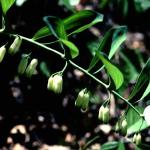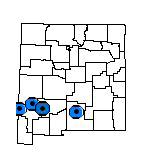Polygonatum cobrense (Southwest Solomon's Seal)
POLYGONATUM COBRENSE (WOOTON & STANDLEY) GATES IS NOW A SYNONYM OF POLYGONATUM BIFLORUM (WALTER) ELLIOTT; SALOMONIA COBRENSIS WOOTON & STANDLEY
Perennial herb from creeping, knotted rhizomes; stems erect or arching, unbranched, glabrous, naked below, leafy above, with one or more papery sheathing bracts at base; leaves alternate, glabrous, with parallel veins, elliptic, 4-10 cm long, 1.0-3.2 cm wide, obtuse or acute at the apex, narrowed at the base to a broad petiole 3-4 mm long; inflorescence axillary; peduncles bent downward, flattened, 1-2-flowered; flowers fragrant, ivory-white with greenish veins, tubular, 17-23 mm long; fruit a several-seeded berry up to 6 mm in diameter. Flowers May and June.
Polygonatum commutatum has leafy bracts, smaller flowers, and is not known to occur in southern New Mexico. Polygonatum vegetatively resembles the genus Maianthemum (Smilacina), but the flowers of Polygonatum are borne in the leaf axils whereas Maianthemum species have a terminal raceme or panicle.
New Mexico, Catron, Grant, Otero, and Sierra counties, Black Range, Mimbres, Pinos Altos, and Sacramento mountains; adjacent Arizona, White Mountains, and Texas, mountains of the Trans-Pecos region.
Sandy humus soils on shaded slopes or shady places beneath trees in pion-juniper-oak woodland to upper montane coniferous forest; 1,680-2,650 m (5,500-8,700 ft).
Polygonatum cobrense is treated as a synonym of P. biflorum in Flora of North America, Vol. 26 (2002). The NMRPTC accepts this taxonomic treatement. Polygonatum biflorum is a common species in the eastern U.S., thus plants in NM, AZ, and western Texas no longer meet NMRPTC criteria as rare. Plants in NM, AZ, and TX are disdunct from the eastern population by more than 300 miles. Federick Utech, author of the FNA treatement states, "Detailed molecular and enzymatic analysis at the population level is needed range-wide, in conjunction with karyological and morphological study." Such study might re-establish Southwest Solomon's seal as an entity worthy of taxonomic recognition.
This plant is disjunct from its eastern populations where it is more common. It remains rare in the Southwest and should be considered for conservation when found locally. Frequency and abundance in the Southwest should be assessed with additional field surveys. Management activities that reduce the tree canopy may negatively effect this shade-loving plant.
Ownbey, R.P. 1944. The Liliaceous genus Polygonatum in North America. Annals of the Missouri Botanical Garden 31:373-414.
Flora of North America Editorial Committee. 2002. Flora of North America, volume 26. Oxford University Press, New York.
For distribution maps and more information, visit Natural Heritage New Mexico




